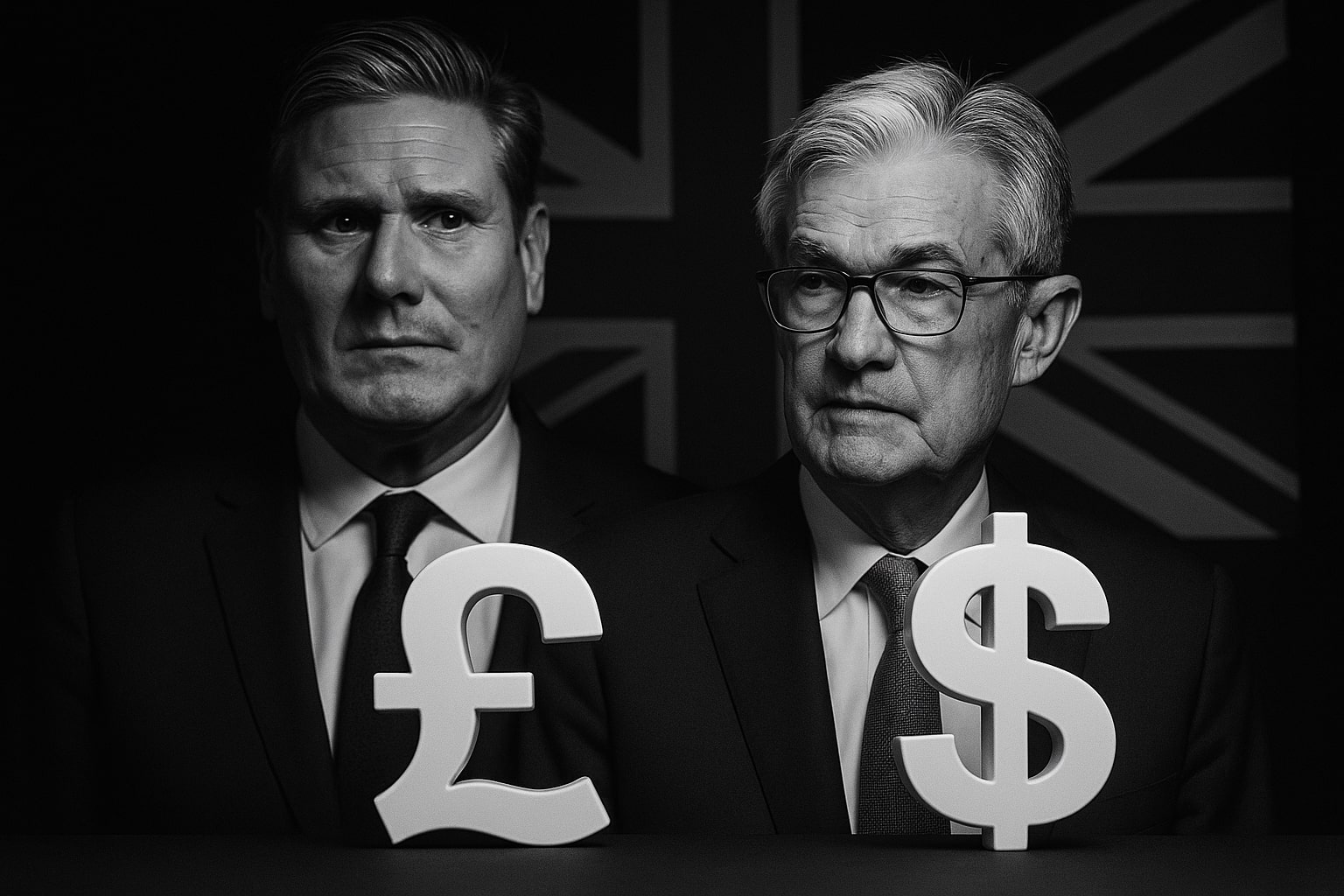
GBP/USD Price Forecast - Pound Slumps Toward 1.3000 as BoE Cut Bets and Fiscal Warnings
The Pound drops 4.8% from September highs to 1.3070, pressured by UK tax-hike signals and dovish BoE expectations. With the U.S. Dollar Index at 99.85 and 10-year gilts at 4.42% | That's TradingNEWS
GBP/USD (British Pound to U.S. Dollar) Slumps Toward 1.3000 as BoE Dovish Turn, Reeves’ Fiscal Warning, and Fed Resilience Trigger Broad Sterling Selloff
The British pound (GBP/USD) has entered a critical downward phase, sliding to a six-month low at 1.3070, pressured by fiscal tightening warnings from UK Chancellor Rachel Reeves, renewed expectations of a Bank of England (BoE) rate cut, and persistent U.S. dollar strength ahead of key macro events. The currency pair, once trading near 1.3725 in September, has now erased nearly 4.8% of its value, with traders eyeing the 1.3000 threshold as the next test amid deep policy divergence between London and Washington.
This week’s moves encapsulate a toxic combination of domestic and global factors: fears of higher UK taxes, weak growth data, and a dollar bolstered by fading Fed rate-cut expectations. The U.S. Dollar Index (DXY), hovering near 99.85, reached its highest level since August, while U.S. Treasury yields firmed above 4.4%, amplifying downside pressure on sterling.
Fiscal Anxiety: Reeves’ Pre-Budget Statement Hammers Confidence in Sterling
The pound’s latest selloff intensified after Chancellor Rachel Reeves issued a pre-Budget address outlining her intent to raise taxes to close a £22 billion fiscal gap. Reeves emphasized that “difficult decisions on tax and spending” are needed to “protect families from high inflation and borrowing costs,” triggering immediate bond market volatility. The UK 10-year gilt yield fell briefly to 4.38%, before rebounding to 4.42%, as investors priced in slower growth and dovish BoE pressure.
Analysts interpret Reeves’ rhetoric as political groundwork for an Autumn Budget that could shift the BoE’s stance toward easing. Reeves’ comments are widely seen as an implicit nudge for Governor Andrew Bailey to accelerate rate cuts, potentially as early as December 2025. This perception contributed to the pound’s breakdown below 1.3100, erasing weeks of accumulation and confirming a bearish technical bias.
BoE Policy Divide: 35% Odds of a Cut, 3.75% Rate Target in Focus
Markets are pricing in a 35% chance of a 25-basis-point cut at the upcoming BoE policy meeting, which would lower the bank rate to 3.75%. This follows softer UK data, including headline inflation at 3.1% in October, slightly above forecasts, but far from the double-digit peaks seen in 2023.
Labor market conditions have cooled, with hiring slowing across manufacturing and construction. The Office for National Statistics reported falling vacancies and subdued wage growth — key data that reinforce expectations of a dovish shift.
However, BoE officials remain divided. Some members, including MPC’s Breeden, continue to highlight sticky service inflation. Others favor preemptive cuts to stimulate activity. This division fuels volatility around GBP/USD, which currently oscillates between 1.3070–1.3140, awaiting a catalyst from Thursday’s announcement.
U.S. Dollar Strength: Powell’s Resilience and Fed Data Undermine Sterling
Across the Atlantic, the U.S. dollar (USD) continues to assert dominance, supported by a resilient economy and hawkish rhetoric from the Federal Reserve. Chair Jerome Powell reiterated that no decision has been made regarding rate cuts, dismissing expectations for a December easing.
The U.S. Non-Farm Payrolls (NFP) report added 195,000 jobs in October, beating expectations and reinforcing the Fed’s “higher for longer” stance. Meanwhile, San Francisco Fed President Mary Daly and Chicago Fed’s Austan Goolsbee both stressed that inflation remains above the 2% target, signaling continued policy restraint.
This hawkishness keeps the dollar bid, contrasting sharply with the BoE’s dovish drift. The result is a widening interest rate differential, now favoring the dollar by nearly 100 basis points, anchoring GBP/USD near multi-month lows.
Technical Breakdown: Double-Top Pattern Confirms Bearish Structure
Technically, GBP/USD (1.3140 → 1.3070) has completed a double-top formation, with the neckline positioned around 1.3100 — a level now converted into strong resistance. The measured move from the September peak of 1.3725 implies a target near 1.2580, consistent with the 38.2% Fibonacci retracement from the 2023–2025 rally.
Momentum indicators confirm the selloff:
-
RSI: 30–32 range (oversold but uncorrected)
-
MACD: deep in negative territory with widening histograms
-
50-day & 200-day EMAs: both declining, confirming a sustained bearish trend
Support zones are clustered around 1.3060, 1.3000, and 1.2970, while resistance sits at 1.3130, 1.3200, and 1.3250.
Traders eye a potential oversold bounce if the pair reclaims 1.3130, but sustained upside is unlikely without a BoE surprise or softer U.S. data.
Read More
-
IVE ETF Near $212: Is This S&P 500 Value Play Still Cheap for 2026?
20.12.2025 · TradingNEWS ArchiveStocks
-
XRP ETFs XRPI at $11.07 and XRPR at $15.76 Power $1.2B Inflows as XRP Fights for $2
20.12.2025 · TradingNEWS ArchiveCrypto
-
Natural Gas Price Forecast: NG=F Tests $3.60 Support as LNG Boom and $5 Henry Hub Calls Build Into 2026
20.12.2025 · TradingNEWS ArchiveCommodities
-
USD/JPY Price Forecast - Pairs Surges After BoJ’s 0.75% Hike as Pair Eyes 161.50 Resistance
20.12.2025 · TradingNEWS ArchiveForex
Macro Divergence: U.K. Weak Growth vs U.S. Economic Expansion
The divergence between U.S. and U.K. economic fundamentals underpins the pound’s structural weakness. The UK economy grew only 0.3% in Q3, compared to 1.9% annualized U.S. GDP growth. The British economy faces headwinds from stagnant productivity, high energy costs, and weak consumer confidence.
Moreover, Reeves’ fiscal tightening coincides with subdued private sector activity. FTSE 100 stocks fell 1.0% this week, signaling broader investor unease. In contrast, U.S. equities remain firm as corporate earnings continue to outperform expectations, underscoring the relative appeal of dollar-denominated assets.
Market Reaction: Traders Hedge Ahead of BoE, Elevated Volatility Pricing
Implied volatility on GBP/USD options surged to 10.8% annualized, reflecting nervousness ahead of Thursday’s decision. Traders are heavily positioned in short-sterling futures, and some are deploying straddle strategies to capture potential two-way moves.
Derivatives data suggest heavy positioning between 1.2950–1.3250, implying that a breakout from this corridor could trigger algorithmic follow-through. If BoE delivers a dovish hold, downside risk intensifies toward 1.2950, while a surprise hawkish stance could spark a squeeze back toward 1.3300.
Global Factors: U.S. Political Risk and Treasury Dynamics
Adding another layer of complexity, the upcoming U.S. Supreme Court hearings on former President Donald Trump’s tariff policies inject further uncertainty into dollar flows. Should the court hint at trade restrictions returning in 2026, the dollar could see renewed inflows as investors seek safety.
Additionally, the U.S. government funding standoff continues to threaten a partial shutdown. While markets have largely priced in the risk, prolonged gridlock could strengthen the dollar in risk-off scenarios — worsening GBP/USD downside momentum.
Analyst Sentiment: Consensus Tilts Bearish
Institutional sentiment remains bearish on sterling. MUFG warns that Reeves’ pre-Budget tone “sets the stage for lower gilt yields and faster BoE easing.” Meanwhile, ING and Goldman Sachs remain split: ING expects a hold, while Goldman sees a 25-bp cut this week.
Hedge fund flow data confirm bearish exposure: speculative shorts rose 18% week-over-week, according to CFTC data, marking the highest bearish positioning since March.
Technical and Fundamental Convergence: Downside Bias Dominates
The intersection of fiscal caution, dovish BoE expectations, and resilient U.S. macro data leaves GBP/USD trapped in a downward spiral. Each rally attempt is met with renewed selling pressure near 1.3150–1.3200, while buyers remain hesitant amid the policy divide.
The market bias remains tilted toward a short-term continuation of the downtrend, with key levels to watch:
-
Immediate target: 1.3000
-
Medium-term extension: 1.2850 if BoE cuts rates
-
Reversal trigger: sustained recovery above 1.3250
Verdict: GBP/USD – SELL, Near-Term Bearish, Medium-Term Cautious
Given the structural macro divergence, GBP/USD remains a SELL, targeting 1.3000 in the short term, with extended potential to 1.2850 if dovish BoE and fiscal tightening coincide. While oversold conditions could spark temporary relief rallies, the broader trend favors the dollar as Fed policy remains firmer than the BoE’s.
Until the U.K. demonstrates growth resilience or inflation consistency below 3%, sterling’s path of least resistance remains lower — reinforcing the downside bias heading into the BoE’s November 6th decision.



















